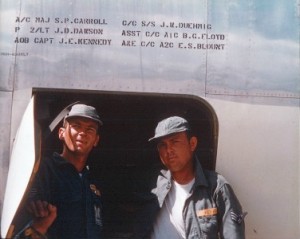In the Age of Stratojets
A former B-47 crew chief looks back at one of the great airplanes of the 20th century
Joseph Duehmig is someone I consider a hero. He’s also the father of one of my closest friends, and given our common Air Force background, he and I have had a few good-natured conversations about his son Mark’s questionable decision to join the Navy. One evening, at Mark’s promotion party to Lieutenant Commander, Mr. Duehmig and I spent some time looking through Lackland Air Force Base’s Internet collection of Air Force basic military training photos.
Duehmig was at Lackland in the early 1950s; I was stationed there with the 3757th Student Squadron in 1987. It was thrilling to share that heritage with a fellow Airman who had signed up only a few years after the Air Force came into being as a separate service. After basic training, we both went on — decades apart — to aircraft maintenance school. Joe Duehmig became a flying crew chief on arguably the most important aircraft of the 20th Century — the Boeing B-47 Stratojet.
The U.S. Army Air Forces (the predecessor of the USAF) sought proposals for a turbine-powered bomber as early as 1943; Boeing would roll out its iconic XB-47 — influenced by captured German data on the swept wing — in September 1947. The B-47, with its six podded engines, is the ancestor of every jet airliner in flight today. Duehmig, stationed at Lake Charles Air Force Base in Louisiana, started crewing, then flying, the Stratojet in 1953. He sat on the step below the pilot and copilot; he was strapped in, but wore no parachute, although he had one at the ready. Lucky for him. “We had an engine catch on fire. I couldn’t see anything; the only way I could see was to stand up and look out between the pilot and co-pilot. We were ready to bail out, but I guess they got the fire out.”
Lake Charles had two wings of Stratojets — 90 jet bombers — plus a wing of Boeing KC-97 tankers, with their brutal World War II-era Pratt & Whitney R-4360 radial engines. While he was on temporary duty, Duehmig’s first B-47 was lost in a refueling accident over the Gulf of Mexico. “They dropped the rear gear to slow down; one of the planes came over the top of mine and his gear hit the canopy and knocked it off,” he recalls. The bombardier/navigator, down below in the nose of the aircraft, ejected after hearing the impact and roar of the wind after the canopy separated. He was never found. The pilot and co-pilot brought the crippled jet back to Lake Charles, where it was readied for a trip back to Boeing’s Wichita, Kansas, facility for repairs. When the Bomb Wing would deploy (to posts as far afield as Morocco), Duehmig and his fellow maintenance troops would pack minimal tools to keep their silver Stratojets airborne. Skill, and borrowed wrenches from the transient maintenance crew were all they needed. “Once or twice a year, I flew a ‘globetrotter’ mission,” he says. “We’d be up for 24 hours, refuel four times. Sometimes we’d have a sleeping bag, so the pilot and co-pilot could take a nap.”
Joseph Duehmig also crewed Boeing B-29s and Lockheed T-33s. After he left the Air Force, he returned to Indiana, raised four boys — Mark, Joe, Bob, and Dave (UPS Douglas DC-8 and Boeing 757/767/747 pilot) — and worked in the fledgling computer industry.
He’s a soft-spoken and honorable man, whose term of enlistment included witnessing the dawn of the jet age.
/https://tf-cmsv2-smithsonianmag-media.s3.amazonaws.com/accounts/headshot/Sotham_photo.jpg)



/https://tf-cmsv2-smithsonianmag-media.s3.amazonaws.com/accounts/headshot/Sotham_photo.jpg)